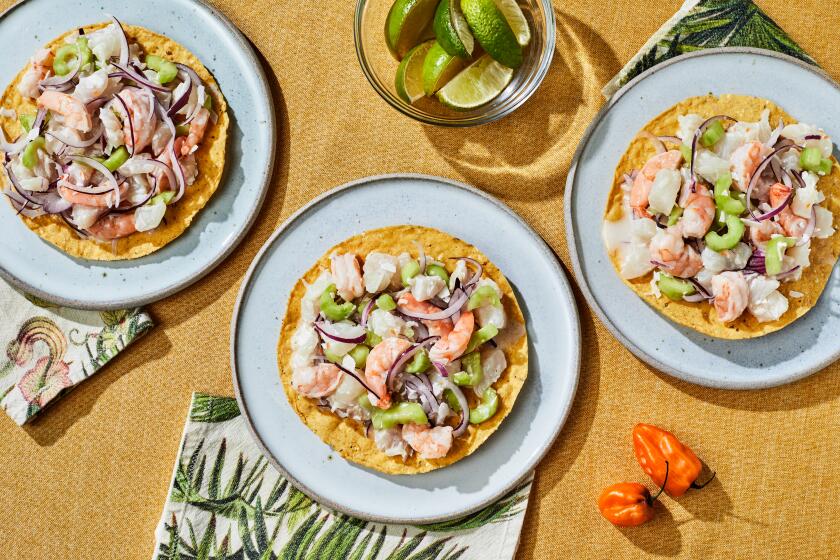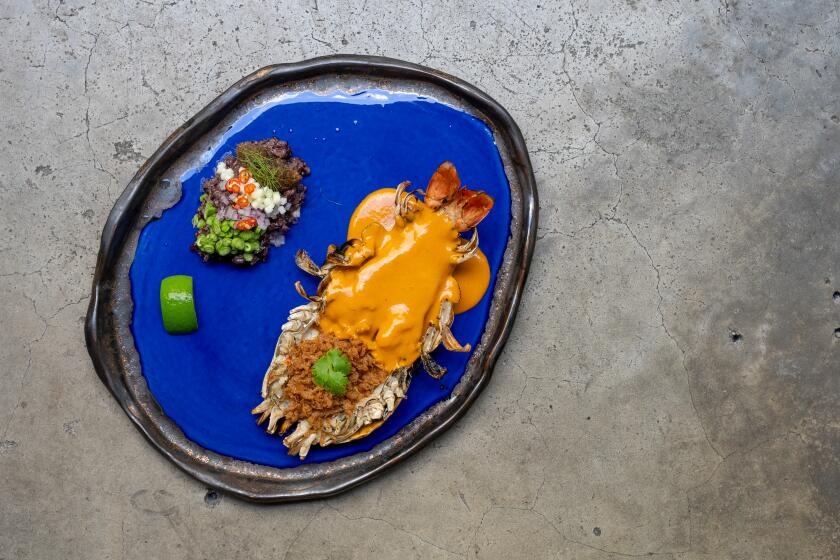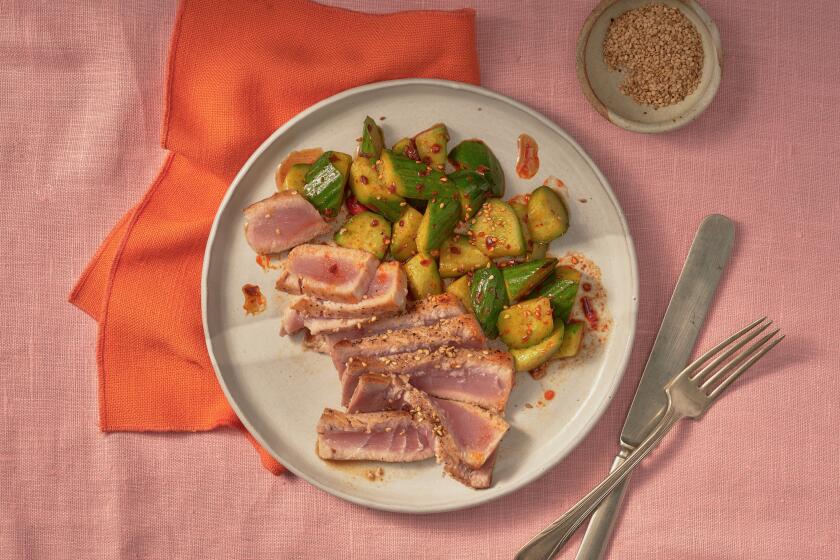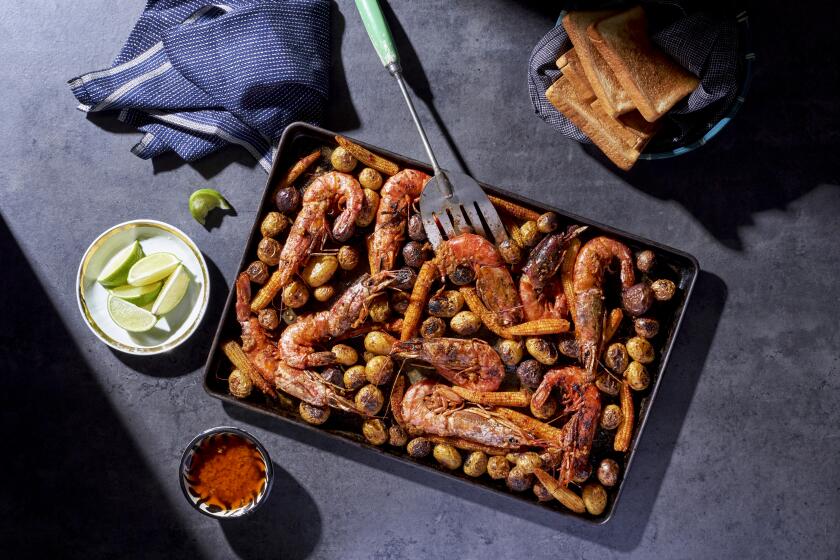Seafood hot pot (haemul jungol)
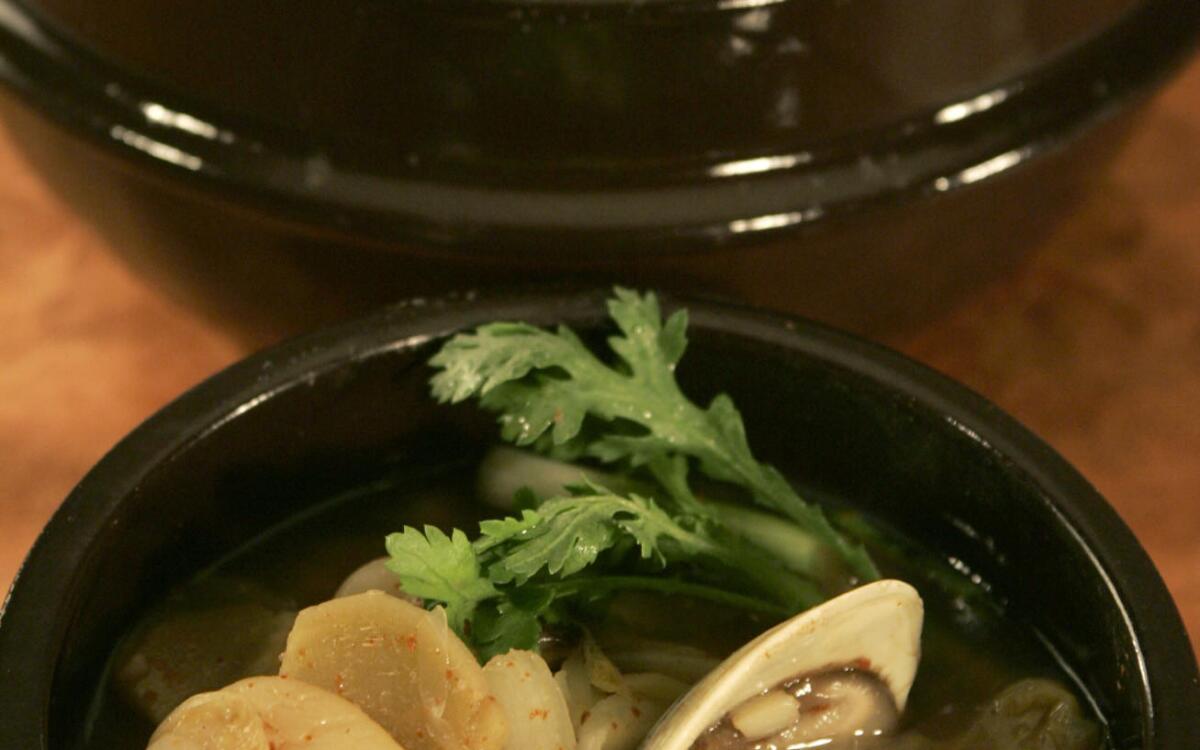
Mention comfort food in our Italian-Irish-Russian-Jewish-descended household and what comes to mind is Korean food. Not restaurant food, but home cooking -- dishes whipped up in the kitchen by my honorary daughter Kyung Min (Coco), who manned the stove while my two other daughters and a couple more teenage girls sat on the kitchen counters kicking their feet, talking about boys and waiting for their after-school snacks.
And what after-school snacks they were! Coco, who lived with us during her senior year of high school, made bulgogi (“fire meat,” or marinated stir-fried beef), pancake and noodle dishes, and everyone’s favorite: bibim bap (marinated beef and mixed vegetables over rice with a fried egg on top). And when Coco’s grandmother, or Halmoni (as we all called her) visited, the parade of dishes was even more impressive. Halmoni would make amazing arrays of zucchini and carrots or potatoes and plump mushrooms, finely sliced and sauteed with fragrant sesame oil. Bundles of marinated spinach, crisp and green, seasoned with garlic and soy sauce. Beef, of course. Soy-seasoned and stir-fried or sometimes, as with her short ribs, braised with onions and green peppers. And noodles -- delicious platefuls of steaming noodles studded with mushrooms, green onions, slivers of carrot.
I was happily reminded of those days recently when I tried out recipes from a new cookbook, “Eating Korean: From Barbecue to Kimchi, Recipes From My Home,” by Cecilia Hae-Jin Lee. Working with my daughter Patricia, I made green onion pancakes (pa jun), spicy radish salad (mu sangchae), simmered tofu (dubu jolim), and grilled baby octopus (jjukkumi). With no experience cooking Korean food ourselves, in about an hour and a half, we had dinner on the table.
We hadn’t picked dishes Coco and Halmoni had made, so we weren’t sure about the end results to aim for, and there aren’t many food photos in the book (although there are often-amusing shots of the author’s family and friends eating and cooking). So we made the kinds of mistakes you make when trying recipes for the first time. We turned the first pancake over too soon (it fell apart), forgot to put the octopus on the grill when the coals were hottest (it took longer to cook) and cut the tofu into cubes instead of slices (it was harder to brown).
But hey -- as each dish came to the table, we grinned with satisfaction at the familiar aromas and flavors. The green onions were wilted and sweet in the oil-crisped pancake. The tofu was redolent of garlic and had a nice chili kick. The octopus was spicy, chewy and pleasantly charred.
Even if you happen to be lucky enough to have a Korean grandma on hand to cook for you, Lee’s book is a great resource. A first-generation immigrant, she says in a preface that the recipes are from a Korean American perspective: some very traditional, some modern or simplified. She encourages her readers to use her recipes as guides, varying proportions and ingredients when the season or mood strikes.
Lee may have begun learning about Korean cooking in her mother’s kitchen, but she’s followed up with field research in other kitchens here and in Korea. Her recipes may be flexible, but they’re full of information. A food writer and past contributor to the Times Food section, she lays down the basics of Korean home cooking not only for non-Koreans interested in exploring the cuisine, but for next-generation Korean Americans who aren’t food pros themselves.
She’s a bridge between Coco and her grandma, for example, explaining secrets that Halmoni doesn’t even think of as secrets, suggesting substitutions and shortcuts that Coco might not figure out for herself and offering advice Coco might not know she needs. Lee mentions, for example, that some companies dye their mung beans, so it’s best to opt for the more expensive brands. She explains when you can substitute English, French or Persian cucumbers for the smaller Korean variety (though not in cucumber kimchi) and how to substitute Asian soy milk for dried soybeans in a broth.
She’s a bridge between Coco and me, too, describing ingredients and spelling out techniques that my grandmother didn’t teach me. Lee explains the basics, providing recipes for tidbits that many home cooks take for granted, explaining how to toast sesame seeds, how to make some of the many dipping sauces offered on the Korean table. She gives recipes for celebratory dishes and menus for special occasions, but she also provides scores of simple three- and four-ingredient everyday preparations: rice and beans, rice and chestnuts, rice and soybean sprouts, cinnamon-ginger tea, pine nut porridge.
This cookbook’s strength is its down-to-earth conversational tone; the charming reminiscences and family photos interspersed between the recipes give it a friendliness and accessibility that’s disarming.
But therein lies the book’s weakness too: More food photos and fewer pictures of smiling children might cut the charm quotient, but it would be very helpful to cooks trying to figure out what seasoned bellflower root or spicy dough flake soup should look like when completed. And the 25 pages devoted to describing Korean celebrations mingle memories, factoids and menus without the kind of helpful insights that would encourage readers to plan their own special meals.
And though Lee encourages experimentation in her preface, she offers exact amounts, not ranges, in her recipes. This led to mid-procedure panic a few times as we tested recipes (my pancake batter isn’t thin enough!). And because the amount of sugar called for in her sweet potato noodles seemed excessive to some tasters, it might have made more sense as a “to taste” ingredient.
On the other hand, the detailed ingredient glossary is comprehensive, informative and easy to use. There’s a separate, also very useful, index of dishes listed by Korean name. The chapters are well organized, following categories as dictated by Korean tastes: rice and porridges, kimchi, side dishes (mit banchan), flatcakes and jun (flat-fried dishes), soups and hot pots, noodles and dumplings, seafood, meats and poultry, desserts, teas and snacks, and special-occasion dishes. Recipe headnotes are informative and contain useful cooking tips.
And Lee’s food is delicious! Her seafood hot pot is a marvel of texture and flavor contrasts. A bite of sweet scallop has a hot finish, thanks to the chile-spiked broth. A mouthful of crunchy cabbage carries a surprise of fresh ginger slices and the unique tang of crown daisy leaves (a Korean herb). All the work for this dish is in cleaning and cutting up the shellfish and vegetables -- cooking is a quick 10- to 15-minute simmer.
Sweet potato noodles (translucent spaghetti-shaped noodles made of sweet potato starch, not unlike Chinese mung bean noodles) are, in Lee’s version, a dish for special occasions and guests. The dish combines soy- and sesame-dressed noodles, chewy and slick, with sliced beef and vegetables. Everything’s cooked in stages and then combined, dressed and garnished in a serving bowl. Like its cousin spaghetti, it can be homey or sophisticated, depending on your presentation.
And sauteed tofu is the kind of dish that makes cooking Monday-night supper more fun than it has a right to be. Firm tofu is sliced, browned in a little hot oil, then steamed in a wake-you-up sauce of garlic, green onion and Korean chili powder.
It will be ready before the button pops up on the rice cooker.
In a large heavy pot, add the onion, mushrooms, cabbage, ginger and garlic. Add the broth and bring to a boil.
Add the seafood, chili paste and chili powder. Reduce to a simmer and let cook for about 5 to 10 minutes, until the seafood is cooked through.
Add the green onions and crown daisy stalks and leaves and let simmer for 1 to 2 more minutes. Add salt and pepper if necessary.
Serve by placing the boiling pot in the middle of the table for everyone to share.
Get our Cooking newsletter.
Your roundup of inspiring recipes and kitchen tricks.
You may occasionally receive promotional content from the Los Angeles Times.












